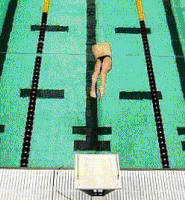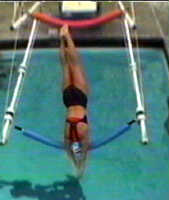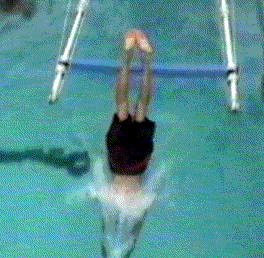

Don't do that Superman Thing! -- Start of downward motion and body attitude.
Body See-Saw
Reach out in front as far as possible with the arms stretched out leading the way. The longer the stretch the more the weight of the body will come forward and will cause your seesaw to tilt at the proper time for the correct angle of entry into the water.

As the body begins to fall, the arms should be leading the way out in front. We like to see the head always in line with the spine and both arms squeezed against the ears. If the arms are falling or pointing down too far the body will begin to rotate for a deeper entry as the arms lead the way down.
 Notice
how the arms are stretched-out in front. Stretching the arms out in front as
much as possible causes the seesaw to tilt the body to the proper angle of entry
into the water.
Notice
how the arms are stretched-out in front. Stretching the arms out in front as
much as possible causes the seesaw to tilt the body to the proper angle of entry
into the water.
Do not use any kind of starting technique that requires you, the swimmer, to enter the water at a sharp angle unless the water is sufficiently deep to do so. The American Red Cross recommends a depth of 9 feet.
Don't do that Superman thing. Raising the head above the line of the spine during the dive will cause the entry to be too shallow (belly flop). We discourage the arms pointing down and then having the head drop down in between the arms. The arms should be leading the way out in front as the head follows the leader and the body follows the head in preparing to enter through a single hole in the surface of the water. Keep your arms together in a tight streamline.
Body Attitude
The hips should be level with each other -- not twisted with one higher than the other.


Body attitude effects the entry causing sharp turns after entry.

We mention body attitude here because this is where the symptom is noticeable. The results of the body attitude occur after entry, causing the diver to turn sharply underwater upon entry, causing additional drag and a slow transition to full-stroke swimming..
Body attitude issues start at the starter's signal. Body attitude is affected as early as the raising of the arms. If one arm is out to the side farther than the other, the beginning symptoms of body attitude issues begin to develop. To see more about this subject of the origin of body attitude problems see the CD-ROM eBook.